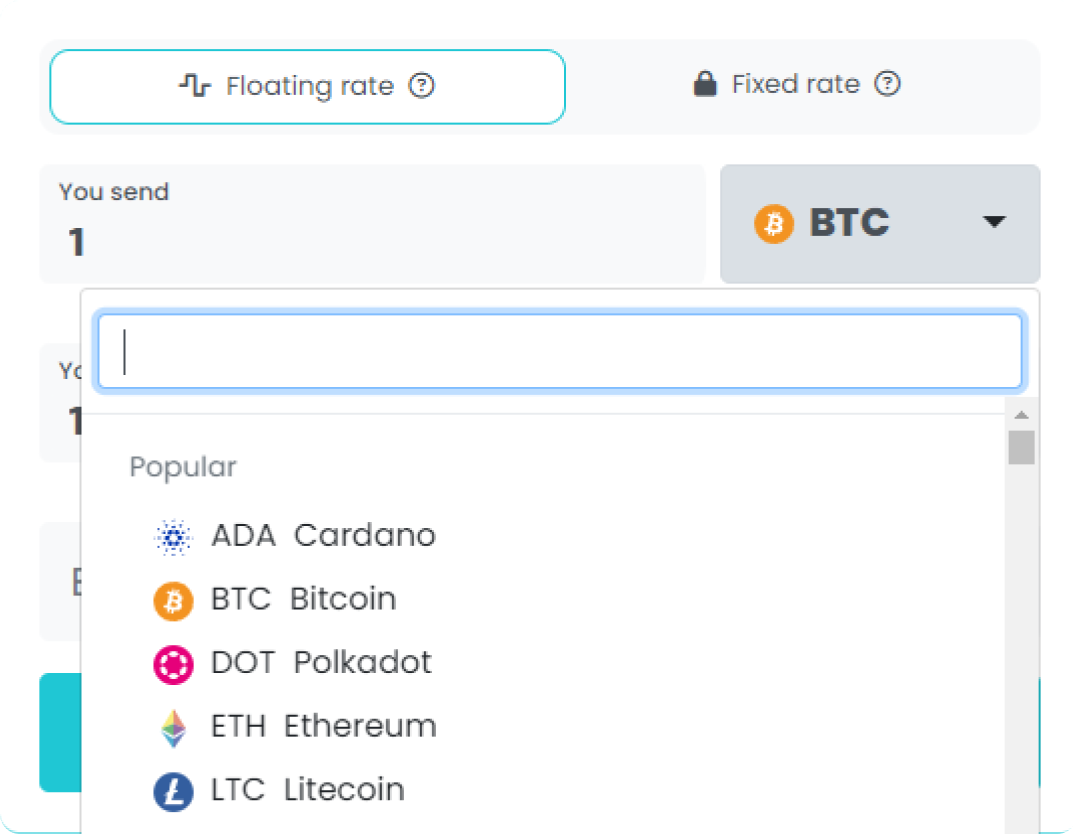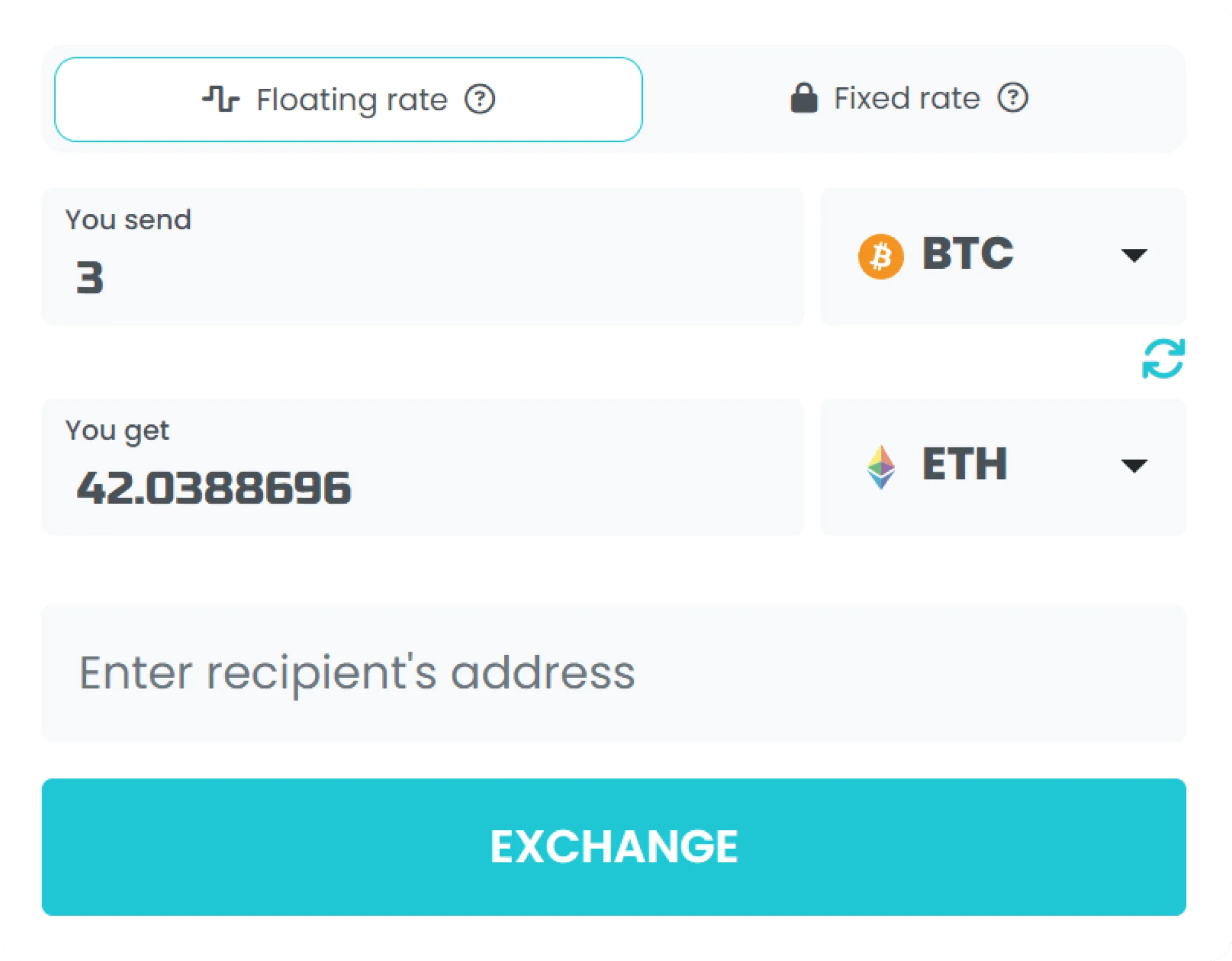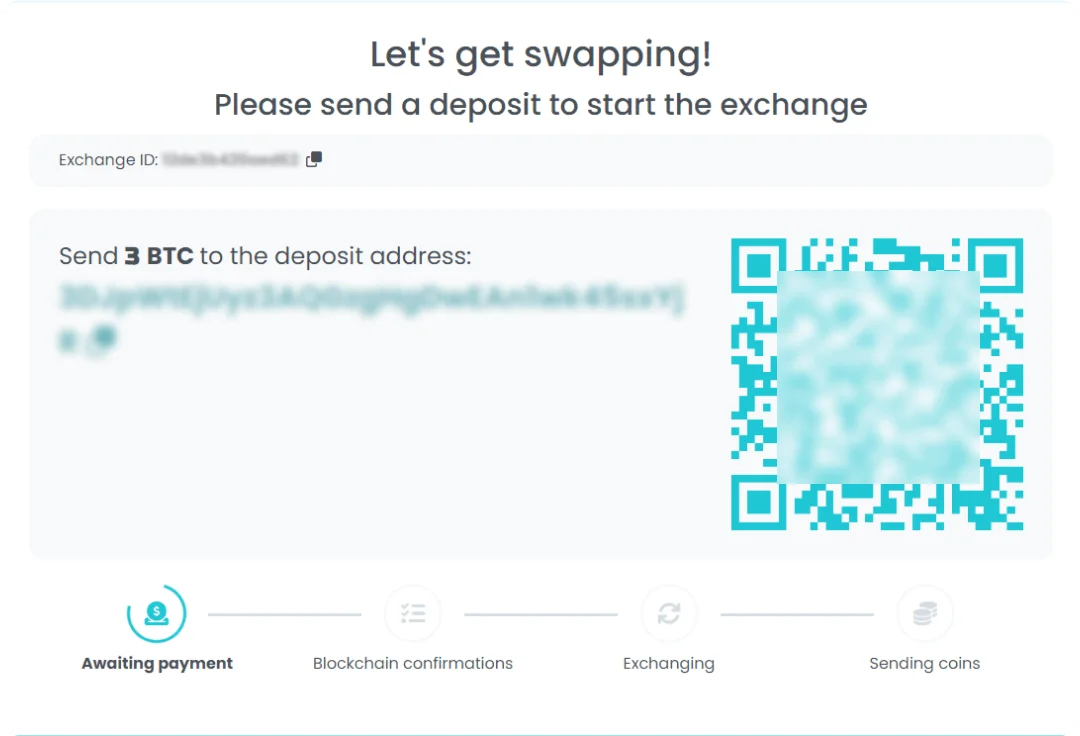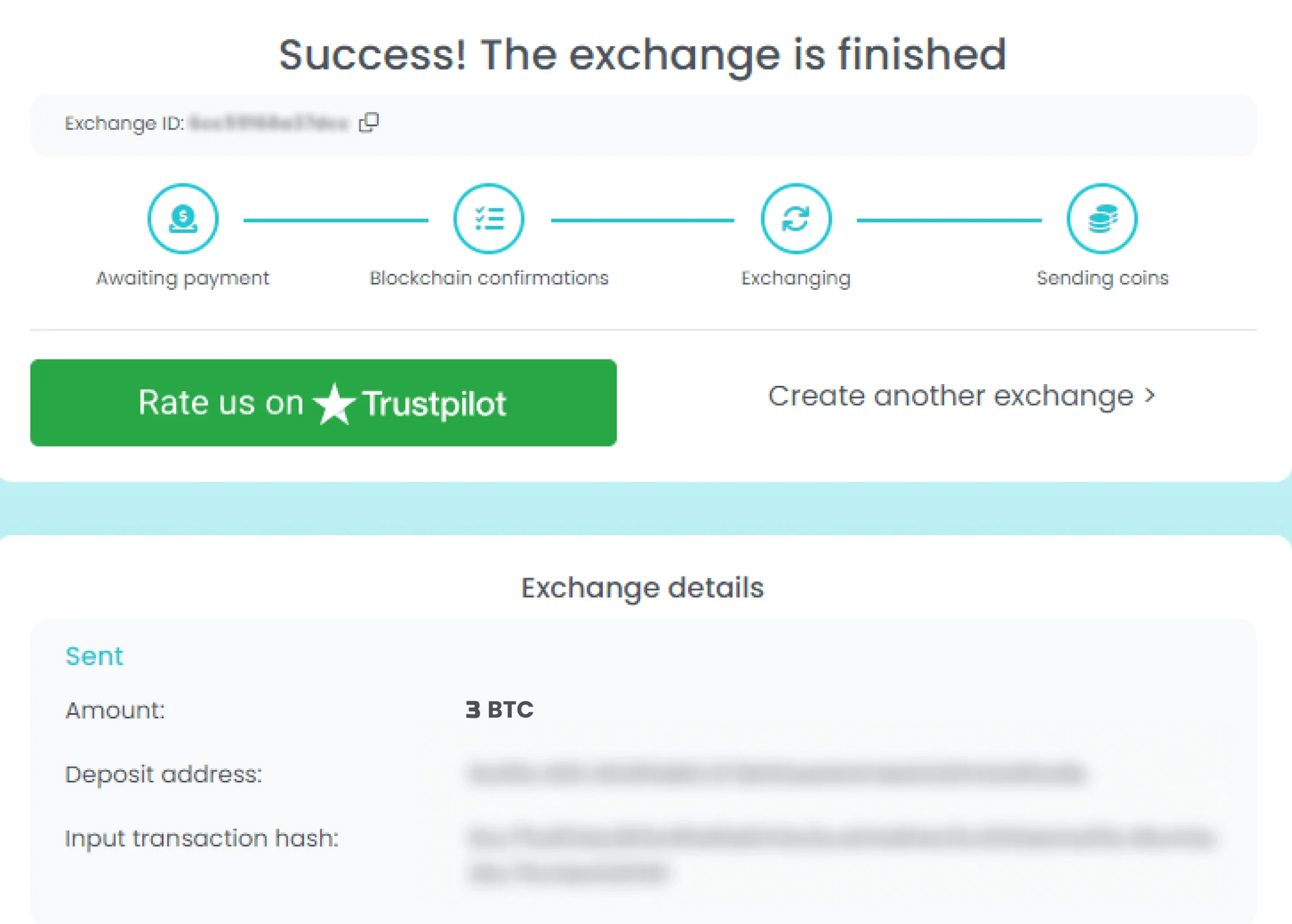How to Exchange Balancer (BAL)
Exchange BAL instantly
Swap Balancer (BAL) in a few clicks on Exchang.io.
Registration and limits free service.
Historical Price Chart
Balancer Current Market Data
| Name | Balancer |
|---|---|
| Price | $3.65 |
| Price Change 24h | -1.33% |
| Price Change 7d | -7.68% |
| Price Change 30d | -17.71% |
| Price Change 60d | -1.52% |
| Market Cap | $199,330,509.36 |
| Circulating Supply | 54,656,714.55 BAL |
| Volume 24h | $4,117,849.38 |
How to Exchange Balancer in Just a Few Straightforward Steps
If you are looking to BAL exchange, you are in the right place. Swap Balancer in a matter of minutes using Exchang.io crypto exchange. Just adhere to these 4 simple steps.




Benefits of Exchanging BAL on Exchang.io

Simple
We make sure not to overload our website with unnecessary elements. Only the things you need for smooth Balancer conversions.Simple and clear.

Secure
Exchang.io is a safest place to exchange BAL. Get BAL anonymously, without KYC and registration.
In touch
Write to us in any unclear situation with BAL swaps. Our support team is happy to help you 24/7.
Fast
We are constantly upgrading our platform to make Balancer exchanges really fast. The average speed for the swap is about 5-15 minutes.Popular Balancer trading pairs
Here are some popular BAL trading pairs. You can buy BAL with every listed coin on Exchang.io.
How Much Balancer Can I Exchange on Exchang.io?
Exchanging Balancer on Exchang.io is unlimited. You can start swapping BAL right now starting from the lower limit of ≈ $3.
There are no upper limits for Balancer exchanges at Exchang.io. Exchange Balancer with other cryptocurrencies from the list of over 700 coins as much as you want to.
Cross-chain exchanges are available; just choose any coin on any network and click the Exchange button, and we'll do the rest for you
Why exchange Balancer?
Things you will be able to do with exchanged BAL:
Balancer is an Ethereum-based DeFi platform that offers a decentralized exchange for cryptocurrencies. If you hold Balancer cryptocurrency, here are four things you can do with it:
1. Trade on the Balancer exchange: With Balancer tokens, you can trade on the Balancer exchange and swap between different cryptocurrencies. You can use your Balancer tokens as a fee payment method for trades, earning discounted fees in the process.
2. Provide liquidity to earn rewards: Balancer allows users to provide liquidity to various token pools and earn rewards in return. By staking your Balancer tokens, you can earn a share of the trading fees generated by the pool.
3. Participate in governance: Balancer is a decentralized autonomous organization (DAO), which means that holders of its token have voting rights over key decisions in the protocol. You can use your Balancer tokens to participate in the governance process and help shape the future of the platform.
4. Hold it as an investment: Like any other cryptocurrency, Balancer can be held as an investment in hopes of its value increasing over time. However, as with any investment, there are risks involved, and you should do your own research before making any investment decisions.
What is Balancer?
Balancer is a decentralized exchange protocol built on Ethereum that enables users to trade cryptocurrencies in a trustless and non-custodial manner. It uses an automated market maker (AMM) system, which means that trades are executed against a pool of funds rather than against other traders. Balancer is unique in that it allows for customizable pools, where users can create their own portfolio of multiple tokens with different weights.
The Balancer protocol was launched in March 2020 by a team of developers led by Fernando Martinelli and Mike McDonald. It is governed by the BAL token, which is used for voting on governance proposals and receiving a portion of the trading fees generated by the protocol.
Balancer's AMM system works by allowing users to deposit tokens into a liquidity pool and earn a share of the trading fees generated by the pool. When a user wants to make a trade, the pool's smart contract calculates the price based on the ratio of tokens in the pool. This ensures that the pool always has enough liquidity to accommodate trades without having to rely on traditional order books.
One of the main benefits of Balancer over other decentralized exchanges is its ability to create customized pools. Users can choose up to eight different tokens and set their own weights. For example, a user could create a pool consisting of 50% ETH, 25% USDC, and 25% WBTC. This allows for more flexibility in trading strategies and investment portfolios.
Another feature of Balancer is its support for flash loans. Flash loans allow users to borrow funds from a pool without providing collateral as long as the borrowed funds are returned within the same transaction. This enables users to take advantage of arbitrage opportunities and execute complex trading strategies without having to lock up their own funds.
Balancer also has a user-friendly interface and supports a wide range of cryptocurrencies, including many ERC-20 tokens. It has been integrated with major wallets such as MetaMask and Ledger, making it easy for users to connect and trade.
However, Balancer is not without its drawbacks. One issue is the high gas fees associated with using the Ethereum network, which can be prohibitively expensive for small trades. Additionally, the AMM system can lead to impermanent loss, which occurs when the price of the tokens in a pool changes significantly compared to the external market. This can result in a reduction in the value of the trader's share of the pool.
Despite these challenges, Balancer has gained popularity as a decentralized exchange protocol due to its customization options and flexible trading strategies. It has also been used in several DeFi projects, such as liquidity mining and yield farming.
The BAL token is an important aspect of the Balancer ecosystem. It is used for governance, allowing holders to vote on proposals related to the protocol's development and management. Holders of BAL tokens are also entitled to a share of the trading fees generated by the protocol.
The supply of BAL tokens is fixed at 100 million, with around 35% of the total supply allocated for community incentives and development. As of June 2023, the circulating supply of BAL tokens is around 20 million, with a market capitalization of over $1 billion USD.
There have been some concerns about the distribution of BAL tokens, as a significant portion of the supply is held by the founding team and early investors. However, the team has stated that they are committed to decentralization and have taken steps to ensure that the community has a say in the protocol's development.
Balancer faces competition from other decentralized exchanges such as Uniswap, SushiSwap, and Curve. These protocols offer different features and advantages, and users may choose to use one or more depending on their specific trading needs.
Overall, Balancer is a decentralized exchange protocol that offers flexibility and customization in trading strategies. Its use of an automated market maker system and support for flash loans provide additional opportunities for traders. While it faces challenges such as high gas fees and impermanent loss, it has gained a significant user base and continues to be a popular choice among decentralized exchange users.
Brief History of Balancer
Balancer is an automated market maker (AMM) protocol built on the Ethereum blockchain. It was developed by a team of anonymous developers and launched in March 2020.
The protocol's native token, BAL, was introduced through a liquidity mining program that rewarded users for providing liquidity to Balancer pools. The distribution of BAL tokens was designed to be fair and decentralized, with the majority of the tokens going to liquidity providers.
Balancer quickly gained popularity among DeFi enthusiasts and became one of the most popular AMM protocols in the space. Its unique feature of allowing users to create custom pools with up to eight assets made it attractive to traders looking for more flexibility.
In June 2020, Balancer suffered a high-profile security breach in which an attacker exploited a vulnerability in the protocol to drain funds from several pools. The team quickly responded and implemented measures to prevent further attacks.
Despite this setback, Balancer continued to grow and innovate. In September 2020, it launched its second version (v2) with improved functionality, gas efficiency, and user experience.
In November 2020, Balancer announced a strategic partnership with Gnosis, another Ethereum-based project focused on decentralized finance. The partnership aimed to bring new features and integrations to the Balancer platform.
In April 2021, Balancer launched its third version (v3), which introduced several new features, including customizable fees, dynamic weighting, and concentrated liquidity. These innovations were designed to enhance capital efficiency and reduce impermanent loss for liquidity providers.
Also in April 2021, Balancer partnered with Aave, a leading DeFi lending platform, to launch the Aave Balancer V2 pool. This pool allows users to provide liquidity to both Aave and Balancer simultaneously, increasing their earning potential.
In May 2021, Balancer announced a new partnership with Polygon, a Layer 2 scaling solution for Ethereum. The partnership aimed to bring Balancer's AMM functionality to the Polygon network, enabling faster and cheaper transactions for users.
As of June 2021, Balancer had over $3 billion in total value locked (TVL), making it one of the largest DeFi protocols by this metric. Its success can be attributed to its innovative features, strong community, and commitment to decentralization.
Looking ahead, Balancer plans to continue improving its platform and expanding its ecosystem through partnerships and integrations with other DeFi projects. It aims to become a leading player in the rapidly evolving world of decentralized finance.
In conclusion, Balancer is a popular and innovative AMM protocol that has quickly become a key player in the DeFi space. Its fair distribution of tokens, customizable pools, and commitment to decentralization have helped it gain a loyal following among crypto traders and investors. Despite some setbacks along the way, Balancer continues to grow and evolve, and its future looks bright.
Balancer Key Advantages and Unique Features
Balancer is a decentralized finance (DeFi) platform built on the Ethereum blockchain, which provides a unique automated market maker (AMM) protocol for trading cryptocurrencies. Balancer enables users to create and customize their own liquidity pools, which can contain up to eight different tokens with varying weights. This customization feature allows for more flexibility in managing portfolios.
One of the key advantages of Balancer is its ability to provide liquidity for less popular or smaller-cap tokens, which may not be available on other exchanges. By allowing users to create their own pools, Balancer incentivizes liquidity providers and traders to participate in these smaller markets. Additionally, Balancer's fee structure is flexible, allowing pool creators to set their own fees and incentivize liquidity provision.
Another unique feature of Balancer is its use of smart contract-based rebalancing mechanisms. Balancer automatically rebalances each liquidity pool based on the token weights specified by the creator, ensuring that the pool remains stable and efficient. This automated rebalancing process reduces the risk of impermanent loss, which occurs when the value of tokens in a liquidity pool changes unevenly.
Balancer also provides a powerful tool for portfolio management called "smart pools." Smart pools enable users to create customized portfolios that are automatically rebalanced based on predefined rules. For example, a user could create a smart pool that invests 50% of its funds into Ethereum and 50% into Bitcoin, and then automatically rebalances every week to maintain this ratio.
Another advantage of Balancer is its integration with other DeFi protocols and applications. Balancer's liquidity pools can be used by other dApps for trading and lending purposes, increasing the overall liquidity of the ecosystem. Balancer has also integrated with popular wallets like MetaMask and Coinbase Wallet, making it easy for users to access the platform.
Balancer's governance model is another unique feature. BAL, Balancer's native token, grants holders voting rights over protocol upgrades and decisions. This means that the community has a say in the development of the platform and can vote on proposals for changes to the protocol.
Balancer also provides strong security measures to protect user funds. The platform uses audited smart contracts and implements best practices for security, such as contract upgradability and multisig wallets. Additionally, Balancer has a bug bounty program that incentivizes researchers to find and report vulnerabilities.
Balancer's user interface is user-friendly and intuitive, even for those new to DeFi. The platform provides an easy-to-use dashboard that allows users to view their portfolio performance, track liquidity provider rewards, and manage their liquidity pools.
Balancer's liquidity mining program is another incentive for users to participate in the platform. Users who provide liquidity to Balancer pools are rewarded with BAL tokens, which can be staked to earn additional rewards. This program has helped to drive liquidity to the platform and increase the overall value of the BAL token.
Finally, Balancer has a strong team of developers and advisors who bring extensive experience in the blockchain and finance industries. The team includes notable advisors like FTX CEO Sam Bankman-Fried and Compound founder Robert Leshner. This expertise helps to ensure that Balancer remains at the forefront of DeFi innovation and development.
In conclusion, Balancer provides a unique and flexible approach to liquidity provision and portfolio management in the DeFi space. Its customizable liquidity pools, automated rebalancing mechanisms, and governance model make it a compelling option for traders, investors, and liquidity providers. With strong security measures, a user-friendly interface, and a dedicated team, Balancer is well-positioned to continue driving innovation in the DeFi ecosystem.
10 Facts About Balancer
Balancer is a decentralized finance (DeFi) protocol that allows users to create and trade custom cryptocurrency pools.
The Balancer protocol was launched in March 2020 by the Balancer Labs team.
Balancer allows for up to 8 different cryptocurrencies to be included in a pool, with customizable weights for each token.
Balancer's automated market maker (AMM) system adjusts the price of tokens in real-time based on supply and demand within the pool.
BAL is the native cryptocurrency of the Balancer platform, used for governance and liquidity mining rewards.
Balancer has partnered with several other DeFi projects, including Compound, Aave, and Chainlink, to enhance its functionality and extend its reach.
Balancer has seen significant growth since its launch, with over $6 billion in total value locked (TVL) in the protocol as of June 2023.
Balancer has implemented various security measures to protect user funds, including audits, bug bounties, and insurance coverage.
Balancer allows users to earn passive income through liquidity provision and staking of BAL tokens.
Balancer's flexible pool creation and trading features make it a popular choice among DeFi traders and enthusiasts looking for greater control over their investments.
What is the Best Place to Exchange BAL?
Via Exchang.io service you can effortlessly swap Balancer for over 700+ different assets. Begin by selecting BAL and your desired coin, paying attention to the network when making your choice. Next, provide the recipient's wallet address for the coin you're swapping to, and press 'Exchange' to continue. Deposit the required amount of BAL to the address displayed on the screen, ensuring you have the necessary amount to finalize the transaction. Once completed, check your wallet to confirm the arrival of your newly acquired coin. Exchang.io makes exchanging Balancer simple and convenient, allowing you to enjoy a seamless experience with an extensive selection of coins to choose from.
Do I need to create an account on Exchang.io to swap Balancer?
No, you don't need to create an account or provide any personal information to swap Balancer on Exchang.io. The platform is registration-free and doesn't require ID verification. Simply follow the steps provided to buy Balancer with your crypto.
How long does it take to exchange Balancer on Exchang.io?
The exchange process on Exchang.io is fast and typically takes only a few minutes to complete. However, the actual time may vary slightly depending on network traffic and transaction confirmation times.
What is the minimum amount needed to swap Balancer on Exchang.io?
There is a minimum amount required for Balancer exchange on the Exchang.io platform, although this amount can change over time. It's recommended to check the latest requirements on the platform before proceeding.
Is Exchang.io legit? Why should I trust Exchang.io?
Exchang.io is a legitimate platform run by a team of experienced crypto enthusiasts with over 7 years of industry knowledge. The platform aims to provide convenient, fast, and transparent services for its users. To ensure better service delivery, the team keeps a close eye on community feedback through their social networks. You can check reviews on the platform itself to verify their legitimacy.
What are some popular Balancer trading pairs?
Some popular Balancer trading pairs available on Exchang.io include BAL/BTC, BAL/ETH, BAL/LTC, and BAL/USDT, among others.
Are cross-chain exchanges available for Balancer?
Yes, Exchang.io supports cross-chain exchanges for Balancer. You can select any coin on any network, click the 'Exchange' button and Exchang.io will handle the rest.
